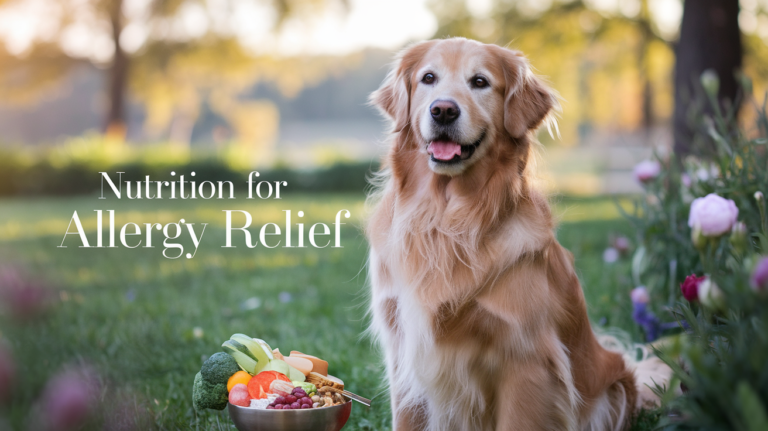A New Year’s Resolution Worth Keeping
As the clock strikes midnight and we usher in a new year, many of us make resolutions to improve our own health and well-being. But what about our furry companions? This year, why not make a resolution that could significantly impact your pet’s life? The key to a longer, healthier life for your beloved pet might just be sitting in their food bowl.
Have you ever wondered if you’re truly providing the best nutrition for your four-legged friend? With the myriad of pet food options available and conflicting advice from various sources, it’s easy to feel overwhelmed. But fear not! Understanding the role of nutrition in your pet’s longevity isn’t just a passing trend—it’s a game-changer that could add years to their life and life to their years.
From decoding your pet’s unique nutritional needs to exploring cutting-edge metabolomic insights, we’re about to embark on a journey that will transform how you think about your pet’s diet. Get ready to discover the power of orthomolecular approaches, learn how to choose the right pet food, and understand the impact of nutrition on age-related issues. By the end of this post, you’ll be equipped with the knowledge to make 2024 the year of optimal nutrition for your furry family member. Let’s dive in and explore how you can keep this New Year’s resolution that both you and your pet will love!
Understanding Your Pet’s Nutritional Needs
A. Historical Perspective
Did you know that just a few decades ago, many pets lived off table scraps and leftover stew? Back then, few people realized how different a pet’s nutritional requirements are from ours. But times have changed. Now we have specialized foods with carefully balanced macronutrients, recommended by veterinarians worldwide. It’s not just about throwing them some meaty bones anymore (though some dogs might say yes, please!). It’s about ensuring a proper mix of proteins, fats, and carbohydrates. The American Veterinary Medical Association (AVMA) has published guidelines that stress balanced macronutrients, which makes sense if you think about all the complex bodily functions each nutrient supports.
I once worked with someone who hated to see food wasted and fed table food to her dog. My coworker was proud of the fact that her dog was not overweight because of the practice of feeding table scraps, but would complain about the cost of antihistamines her dog needed and that her dog was suffering from arthritis and was developing cataracts.
B. Age-specific dietary requirements
As pets age, their nutritional needs change significantly. Puppies and kittens require more calories and protein to support their rapid growth, while senior pets often need fewer calories but more easily digestible nutrients. Here’s a breakdown of age-specific dietary requirements:
| Age Group | Calorie Needs | Protein | Fat | Special Considerations |
|---|---|---|---|---|
| Puppies/Kittens | High | High | Moderate | DHA for brain development |
| Adults | Moderate | Moderate | Moderate | Balanced vitamins and minerals |
| Seniors | Low | Moderate-High | Low | Joint support, digestive aids |
B. Breed-specific considerations
Different breeds have unique nutritional requirements based on their size, activity level, and predisposition to certain health issues. For example:
- Large breed dogs: Need joint-supporting nutrients like glucosamine
- Brachycephalic breeds: Require easily digestible food due to respiratory challenges
- Working breeds: Need higher calorie and protein diets to support their activity levels
C. Health condition-based nutrition
Pets with specific health conditions often require tailored diets:
- Obesity: Low-calorie, high-fiber diets
- Kidney disease: Low-phosphorus diets
- Diabetes: Low-carbohydrate, high-fiber diets
- Allergies: Limited ingredient or hypoallergenic diets
D. Importance of balanced nutrients
A balanced diet is crucial for your pet’s overall health and longevity. Key nutrients include:
- Proteins: For muscle maintenance and growth
- Carbohydrates: For energy
- Fats: For energy, coat health, and nutrient absorption
- Vitamins and minerals: For various bodily functions
- Water: For hydration and overall health
Now that we understand the foundational aspects of pet nutrition, let’s explore the key nutrients that specifically contribute to pet longevity.
E. Common Misconceptions
We’ve all heard them. “Grain-free diets are always better.” “High-protein diets can damage kidneys.” Or my favorite: “If it’s good enough for me, it’s good enough for my pet.” But these aren’t always true. Reputable veterinary research explains that carbs aren’t universally evil, high-quality grains can be beneficial, and protein has to be judged for its quality—not just its quantity.
Your pet’s tummy, after all, is different from yours. It’s worth questioning those old myths and looking at what experts say. Because in the end, that can save you a lot of headaches. And vet bills too.
Understanding Your Pet’s Nutritional Needs
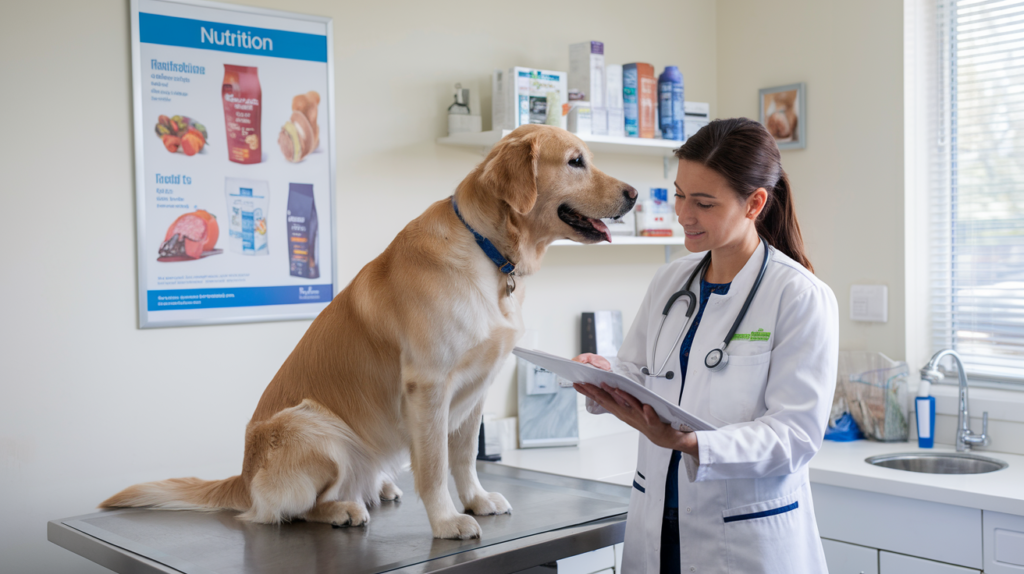
A. Historical Perspective
Did you know that just a few decades ago, many pets lived off table scraps and leftover stew? Back then, few people realized how different a pet’s nutritional requirements are from ours. But times have changed. Now we have specialized foods with carefully balanced macronutrients, recommended by veterinarians worldwide. It’s not just about throwing them some meaty bones anymore (though some dogs might say yes, please!). It’s about ensuring a proper mix of proteins, fats, and carbohydrates. The American Veterinary Medical Association (AVMA) has published guidelines that stress balanced macronutrients, which makes sense if you think about all the complex bodily functions each nutrient supports.
I once worked with someone who hated to see food wasted and fed table food to her dog. My coworker was proud of the fact that her dog was not overweight because of the practice of feeding table scraps, but would complain about the cost of antihistamines her dog needed and that her dog was suffering from arthritis and was developing cataracts.
B. Age-specific dietary requirements
As pets age, their nutritional needs change significantly. Puppies and kittens require more calories and protein to support their rapid growth, while senior pets often need fewer calories but more easily digestible nutrients. Here’s a breakdown of age-specific dietary requirements:
| Age Group | Calorie Needs | Protein | Fat | Special Considerations |
|---|---|---|---|---|
| Puppies/Kittens | High | High | Moderate | DHA for brain development |
| Adults | Moderate | Moderate | Moderate | Balanced vitamins and minerals |
| Seniors | Low | Moderate-High | Low | Joint support, digestive aids |
B. Breed-specific considerations
Different breeds have unique nutritional requirements based on their size, activity level, and predisposition to certain health issues. For example:
- Large breed dogs: Need joint-supporting nutrients like glucosamine
- Brachycephalic breeds: Require easily digestible food due to respiratory challenges
- Working breeds: Need higher calorie and protein diets to support their activity levels
C. Health condition-based nutrition
Pets with specific health conditions often require tailored diets:
- Obesity: Low-calorie, high-fiber diets
- Kidney disease: Low-phosphorus diets
- Diabetes: Low-carbohydrate, high-fiber diets
- Allergies: Limited ingredient or hypoallergenic diets
D. Importance of balanced nutrients
A balanced diet is crucial for your pet’s overall health and longevity. Key nutrients include:
- Proteins: For muscle maintenance and growth
- Carbohydrates: For energy
- Fats: For energy, coat health, and nutrient absorption
- Vitamins and minerals: For various bodily functions
- Water: For hydration and overall health
Now that we understand the foundational aspects of pet nutrition, let’s explore the key nutrients that specifically contribute to pet longevity.
E. Common Misconceptions
We’ve all heard them. “Grain-free diets are always better.” “High-protein diets can damage kidneys.” Or my favorite: “If it’s good enough for me, it’s good enough for my pet.” But these aren’t always true. Reputable veterinary research explains that carbs aren’t universally evil, high-quality grains can be beneficial, and protein has to be judged for its quality—not just its quantity.
Your pet’s tummy, after all, is different from yours. It’s worth questioning those old myths and looking at what experts say. Because in the end, that can save you a lot of headaches. And vet bills too.
Key Nutrients for Pet Longevity
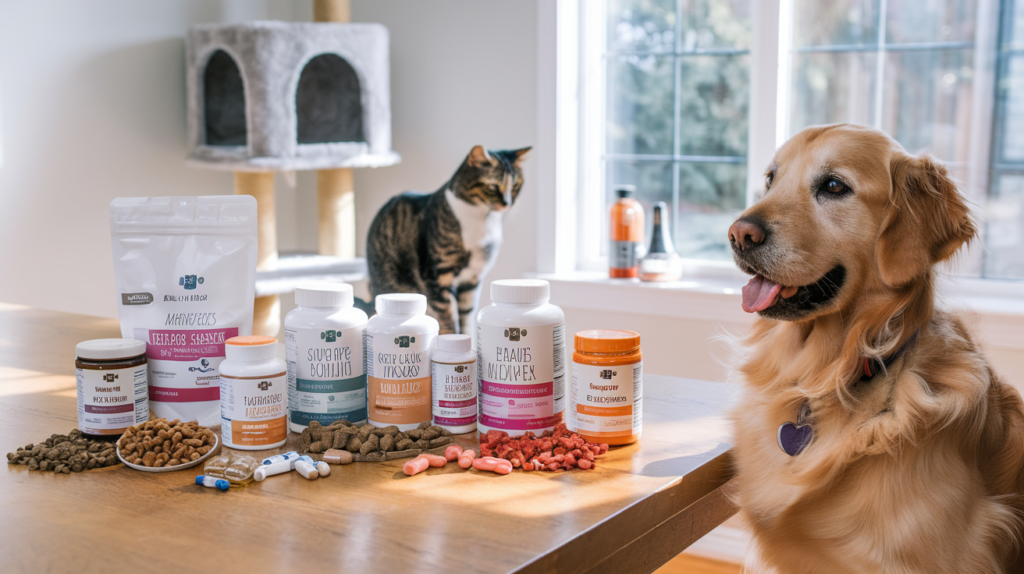
Essential proteins and amino acids
Proteins and amino acids are the building blocks of life. They’re crucial for your pet’s longevity. They play vital roles in:
- Muscle maintenance and repair
- Enzyme production
- Immune system function
- Hormone regulation
Dogs and cats need different amino acid profiles to stay healthy. And the amount of protein each one needs can vary a lot. According to AAFCO (the folks who set nutrition guidelines for pet food), adult dogs need at least 18% protein on a dry matter basis (DMB), and puppies or pregnant dogs need about 22.5% DMB. These are minimums, though—think of them as a starting point.
But here’s where it gets interesting. Dr. Karen Becker, who often talks about a more ancestral or species-appropriate diet, says dogs can thrive on a diet containing closer to 40–50% protein (again, on a dry matter basis). That’s more than double the AAFCO minimum in some cases. She believes our pets’ wild cousins got plenty of protein in their diet, so upping that percentage might mimic how their ancestors ate.
So how do you choose what’s right for your dog? Think about their life stage, their activity level, and maybe even their breed. Are they a couch potato, or do they dash around like a sprinter every morning? If they’re super active, they might benefit from a higher-protein diet. If they’re less active, you might want to stick closer to the standard guidelines, or somewhere in between. We as humans, adjust our diets to support changes in our health goals. As pet parents, we need to change our pets’ diets to adjust to their health goals and life stages.
Healthy fats and omega-3s
Fats are not just energy sources; they’re essential for:
- Cell membrane structure
- Nutrient absorption
- Coat health and shine
Omega-3 fatty acids, particularly EPA and DHA, offer numerous benefits:
- Reduced inflammation
- Improved cognitive function
- Enhanced heart health
- Joint support
Too many saturated or trans fats can cause weight gain and heart issues. Functional medicine often highlights the importance of these healthy fats to curb chronic diseases. So, yes, skip the greasy scraps from the table. Go for high-quality fish oils or pet foods with balanced fat content.
But be careful. Not all fish oils are created equal. So talk to your vet. Look for brands with good sourcing and quality control.
Carbohydrates
This is a big debate. High carbs? Low carbs? Somewhere in between? Metabolomic insights have shown that certain carbs can actually improve gut health by feeding beneficial bacteria. But that doesn’t mean all carbs are good. Simple sugars and fillers could lead to weight gain and energy crashes. Think complex carbs from sweet potatoes or brown rice if your veterinarian (or pet nutritionist) says it’s suitable.
And watch your pet’s reaction. If your dog has more energy or your cat’s litter box output changes drastically, it might be time to adjust the carbs.
Vital vitamins and minerals
A balanced diet should include:
- Vitamin A: vision and immune health
- Vitamin E: antioxidant protection
- Calcium and phosphorus: bone strength
- Zinc: skin health and wound healing
Micronutrients
Vitamins and minerals might sound like small players, but they’re huge in preventing disease and supporting long-term health. Orthomolecular perspectives argue for optimal (sometimes higher) levels of these nutrients to stay ahead of potential deficiencies. For example, did you know that vitamin E helps with immune function, or that a proper calcium-to-phosphorus ratio is crucial for bone health?
These nutrients can be tricky to manage on your own. So consult with your vet before going heavy on supplements. Because the last thing you want is to do more harm than good.
Fiber for digestive health
Dietary fiber supports:
- Regular bowel movements
- Healthy gut microbiome
- Weight management
Aim for a mix of soluble and insoluble fibers from sources like pumpkin, sweet potatoes, and leafy greens.
Hydration and its role
Proper hydration is crucial for:
- Toxin elimination
- Nutrient transportation
- Temperature regulation
- Joint lubrication
Ensure fresh water is always available and consider wet food to increase moisture intake.
Now that we’ve covered the key nutrients, let’s explore how to choose the right pet food that incorporates these essential elements for your furry friend’s longevity.
Dogs and cats require different amino acid profiles:
| Animal | Essential Amino Acids | Protein Requirements (AAFCO) |
|---|---|---|
| Dogs | 10 | 18–22.5% of diet (DMB) |
| Cats | 11 (including taurine) | 26–30% of diet (DMB) |
But remember, if you follow Dr. Becker’s suggestions, that protein requirement might jump to 40% or more (DMB) for your dog. So figure out which approach feels right for you and your furry best friend.
The Impact of a Balanced Diet on Pet Health

Weight Management and Obesity Prevention
Obesity is a huge problem in pets right now. It can lead to diabetes, joint issues, heart disease, and shorter lifespans. You might think a chubby cat is cute—until you see her struggling to climb the couch or develop mobility issues. It’s heartbreaking. Veterinary journals have shown that calorie-controlled diets not only keep pets slim but can also extend their healthy years. So measure those portions. And don’t give in to those sad eyes.
It’s a small price to pay for a longer, happier life.
Joint and Bone Health
A balanced diet isn’t just about preventing weight gain. Nutrients like glucosamine and chondroitin can help maintain joint health, especially in aging pets. Vitamin D is another big player. Orthomolecular and functional nutrition experts say targeted supplements can reduce inflammation and protect cartilage. So if you have a senior dog with creaky hips, or a cat that’s starting to slow down, consider these supports. And always talk to your vet first.
But be patient. Joint health improvements don’t happen overnight. Just like humans, pets need consistent care and proper supplementation for real results.
Immune System Support
Want your pet to fend off colds, infections, or other nasties? Antioxidants like vitamins C and E are your friends. They help combat oxidative stress, which, according to metabolomic research, is linked to aging and chronic diseases. By ensuring your pet gets these nutrients in the right amounts, you’re basically giving them a little shield. It might not be obvious day-to-day, but over the long haul, a strong immune system can make a world of difference.
Cognitive and Neurological Function
We often think about fur and muscle, but the brain matters too. DHA (an omega-3 fatty acid) is known to support cognitive health in both humans and pets. Senior pets, especially, can benefit from foods enriched with DHA and other brain-friendly nutrients. Functional nutrition looks at these holistic connections—because it’s not just about a dog’s body, it’s about their mind too.
Think of it this way: a healthy brain keeps them playful, alert, and learning new tricks even as they age. And who doesn’t love a spry, older dog that can still learn a new command?
Nutrient Balance and Its Effects
The right balance of nutrients in your pet’s diet can have far-reaching effects on their health:
| Nutrient | Function | Health Impact |
|---|---|---|
| Proteins | Muscle growth and repair | Improved strength and mobility |
| Carbohydrates | Energy source | Sustained activity levels |
| Fats | Energy and nutrient absorption | Healthy skin and coat |
| Vitamins | Various bodily functions | Enhanced immune system |
| Minerals | Bone health and metabolism | Stronger bones and teeth |
By providing a balanced diet, you’re not just feeding your pet; you’re investing in their future health and longevity. This approach to nutrition can help prevent many common health issues and ensure your furry friend remains active and vibrant for years to come. As we move forward, we’ll explore how to choose the right pet food that meets these nutritional requirements.
Choosing the Right Pet Food
Decoding pet food labels
Understanding pet food labels is crucial for making informed decisions about your pet’s nutrition. Here’s a breakdown of key elements to look for:
- Ingredient list: Ingredients are listed by weight, with the first few being the most prominent.
- Guaranteed analysis: Shows minimum percentages of protein and fat, and maximum percentages of fiber and moisture.
- AAFCO statement: Indicates if the food meets nutritional standards set by the Association of American Feed Control Officials.
- Life stage: Specifies whether the food is for growth, maintenance, or all life stages.
| Label Element | What to Look For |
|---|---|
| Protein source | Named animal proteins (e.g., “chicken” instead of “meat”) |
| Grains | Whole grains preferred over by-products |
| Artificial additives | Avoid foods with artificial colors, flavors, or preservatives |
| Fat content | Appropriate levels for your pet’s age and activity level |
Commercial vs. homemade diets
Both commercial and homemade diets have their pros and cons:
Commercial diets:
- Convenient and nutritionally balanced
- Quality varies widely between brands
- May contain preservatives or fillers
Homemade diets:
- Allow for complete control over ingredients
- Require careful planning to ensure nutritional balance
- Time-consuming to prepare
Organic and natural options
Organic and natural pet foods are gaining popularity due to their perceived health benefits:
- Organic: Made with ingredients grown without synthetic pesticides or fertilizers
- Natural: Contain no artificial colors, flavors, or preservatives
While these options can be beneficial, it’s important to ensure they still meet your pet’s nutritional needs.
Avoiding harmful ingredients
Be vigilant about avoiding these potentially harmful ingredients in pet food:
- Artificial preservatives (e.g., BHA, BHT, ethoxyquin)
- Artificial colors and flavors
- Meat by-products or unnamed meat sources
- Excessive fillers or low-quality grains
- Added sugars or sweeteners
By carefully selecting your pet’s food based on these guidelines, you’re taking a significant step towards ensuring their long-term health and longevity. In the next section, we’ll explore how to implement a healthy feeding routine to complement your choice of pet food.
Implementing a Healthy Feeding Routine
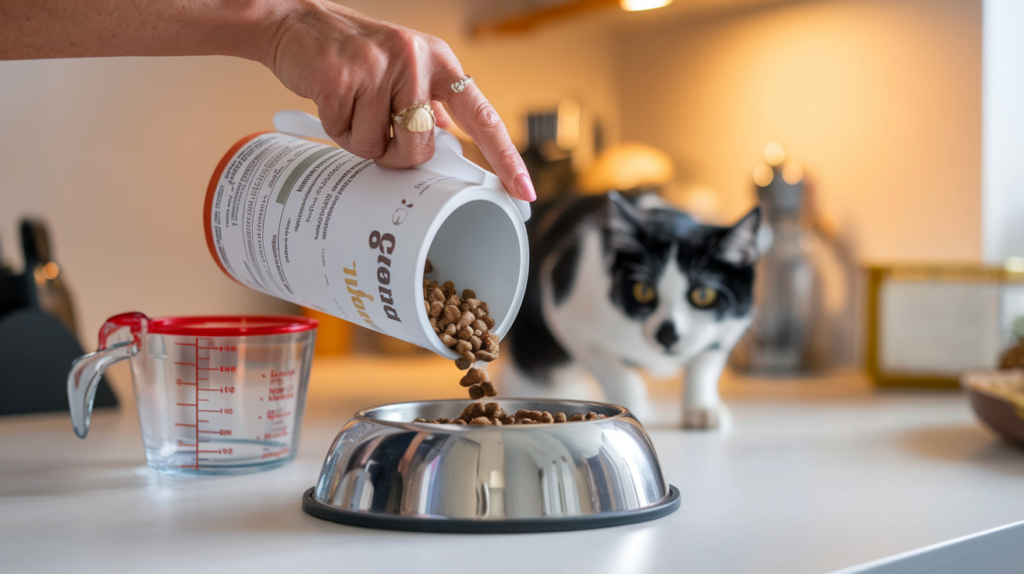
Changing your pet’s diet? Where to start?
So how do you choose what’s right for your dog? Think about their life stage, their activity level, and maybe even their breed. Are they a couch potato, or do they dash around like a sprinter every morning? If they’re super active, they might benefit from a higher-protein diet. If they’re less active, you might want to stick closer to the standard guidelines, or somewhere in between.
Practical tip: Talk to your vet or a pet nutrition expert. Ask about your dog’s specific needs. Don’t just jump to a new diet overnight. Instead, ease into any changes so you can watch for any digestive issues or changes in energy. Always keep your dog’s unique situation in mind. And definitely don’t forget to check the labels on any commercial dog food you buy—look at the guaranteed analysis and figure out how much protein you’re actually getting when you factor out the moisture. That’s the real percentage that matters.
Portion control and feeding schedules
Establishing a consistent feeding routine is crucial for your pet’s health and longevity. Proper portion control ensures your pet maintains a healthy weight, while regular feeding schedules help regulate their metabolism and digestion.
Here’s a guide to help you implement effective portion control and feeding schedules:
| Pet Size | Recommended Meals per Day | Portion Size (% of Daily Intake) |
|---|---|---|
| Small | 3-4 | 25-33% per meal |
| Medium | 2-3 | 33-50% per meal |
| Large | 1-2 | 50-100% per meal |
Remember to adjust portions based on your pet’s age, activity level, and health status. Consult with your veterinarian for personalized recommendations.
Treating responsibly
While treats are an essential part of bonding with your pet, it’s important to use them judiciously:
- Limit treats to 10% of your pet’s daily caloric intake
- Choose healthy, low-calorie options
- Use treats as rewards during training sessions
- Avoid human food as treats, as they can be harmful to pets
Addressing picky eaters
Dealing with a finicky pet can be challenging. Try these strategies to encourage healthy eating habits:
- Stick to a consistent feeding schedule
- Offer a variety of textures and flavors
- Warm up food slightly to enhance aroma
- Use puzzle feeders to make mealtime engaging
- Avoid free-feeding, which can reinforce picky behavior
By implementing these strategies, you’ll create a healthy feeding routine that supports your pet’s longevity and well-being. Next, we’ll explore how metabolomics can provide deeper insights into your pet’s nutritional needs and overall health.
Metabolomic Insights into Pet Longevity
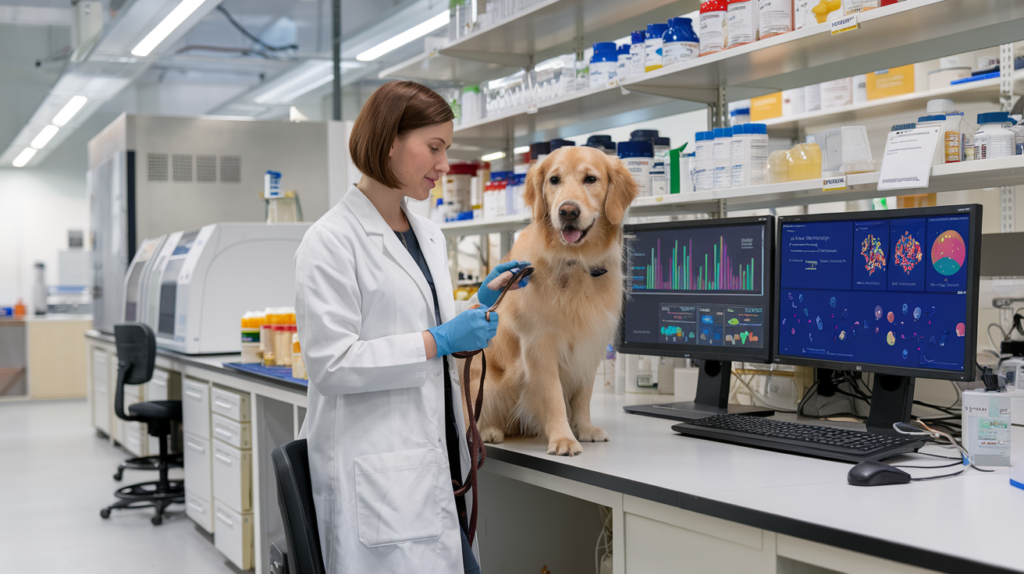
Metabolomic Profiling and Pet Nutrition
Metabolomics, the study of small molecules in biological systems, is revolutionizing our understanding of pet nutrition and longevity. By analyzing the metabolic profiles of pets, researchers can gain valuable insights into how different diets affect their health and lifespan.
Recent studies have shown that metabolomic profiling can:
- Identify biomarkers of aging and disease
- Reveal the impact of specific nutrients on cellular processes
- Help tailor diets to individual pets’ needs
- Predict potential health issues before they manifest
| Metabolomic Insight | Nutritional Implication |
|---|---|
| Elevated oxidative stress markers | Increase antioxidant-rich foods |
| Imbalanced amino acid profile | Adjust protein sources and quality |
| Altered lipid metabolism | Modify fat content and types |
| Disrupted gut microbiome markers | Introduce probiotics and prebiotics |
Practical Takeaways for Pet Owners
Armed with metabolomic insights, pet owners can make informed decisions about their pets’ nutrition. Here are some practical applications:
- Personalized nutrition plans based on metabolic profiles
- Early detection and prevention of age-related diseases
- Optimized supplementation strategies
- Monitoring the effectiveness of dietary changes
By incorporating metabolomic insights into pet care routines, owners can potentially extend their pets’ healthy lifespans. This scientific approach to nutrition allows for a more precise and effective way to support pet longevity.
Next, we’ll explore how to effectively monitor your pet’s health through nutrition, building on these metabolomic insights to ensure optimal well-being throughout their lives.
Monitoring Your Pet’s Health through Nutrition
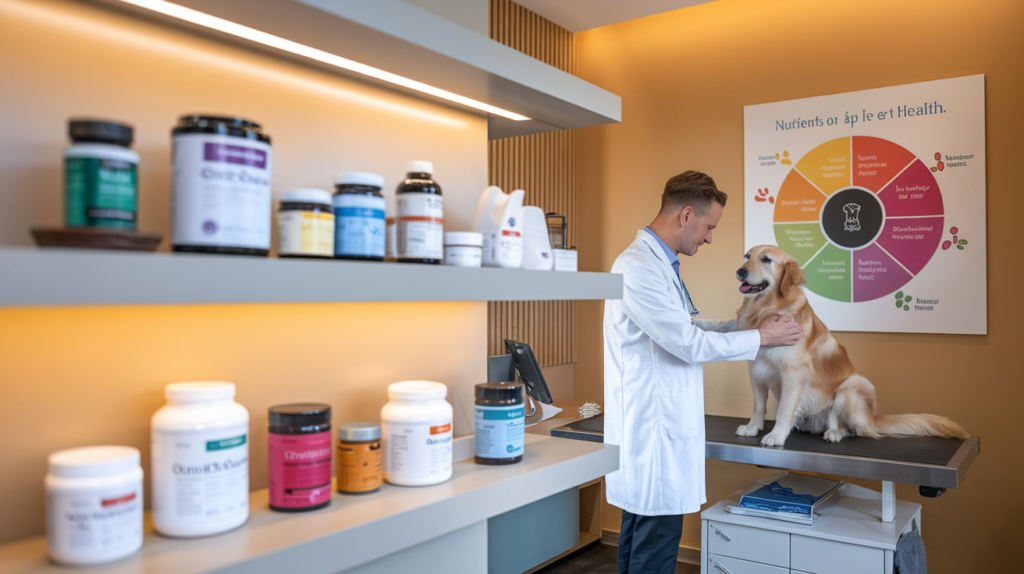
Signs of proper nutrition
When your pet is receiving proper nutrition, you’ll notice several positive signs:
- Shiny, healthy coat
- Clear, bright eyes
- Consistent energy levels
- Healthy weight
- Regular bowel movements
These indicators reflect your pet’s overall health and well-being. A well-nourished pet will also have:
- Strong teeth and gums
- Good muscle tone
- Proper hydration
- Healthy skin with no excessive shedding
| Aspect | Signs of Proper Nutrition | Signs of Poor Nutrition |
|---|---|---|
| Coat | Shiny and smooth | Dull and brittle |
| Energy | Consistent and balanced | Lethargic or hyperactive |
| Weight | Healthy and stable | Underweight or obese |
| Digestion | Regular, formed stools | Diarrhea or constipation |
Recognizing nutritional deficiencies
It’s crucial to identify potential nutritional deficiencies early. Watch for:
- Unexplained weight loss or gain
- Excessive shedding or hair loss
- Lethargy or weakness
- Digestive issues (vomiting, diarrhea)
- Skin problems or allergies
These symptoms may indicate your pet isn’t getting the right balance of nutrients. Consult your veterinarian if you notice any of these signs.
Regular vet check-ups and dietary adjustments
Regular veterinary check-ups are essential for monitoring your pet’s nutritional health. Your vet can:
- Assess your pet’s body condition
- Perform blood tests to check nutrient levels
- Recommend dietary adjustments based on age, health, and lifestyle
As your pet ages or experiences health changes, their nutritional needs may shift. Work closely with your vet to make necessary adjustments to ensure optimal nutrition throughout your pet’s life.
Orthomolecular Approaches for Pets
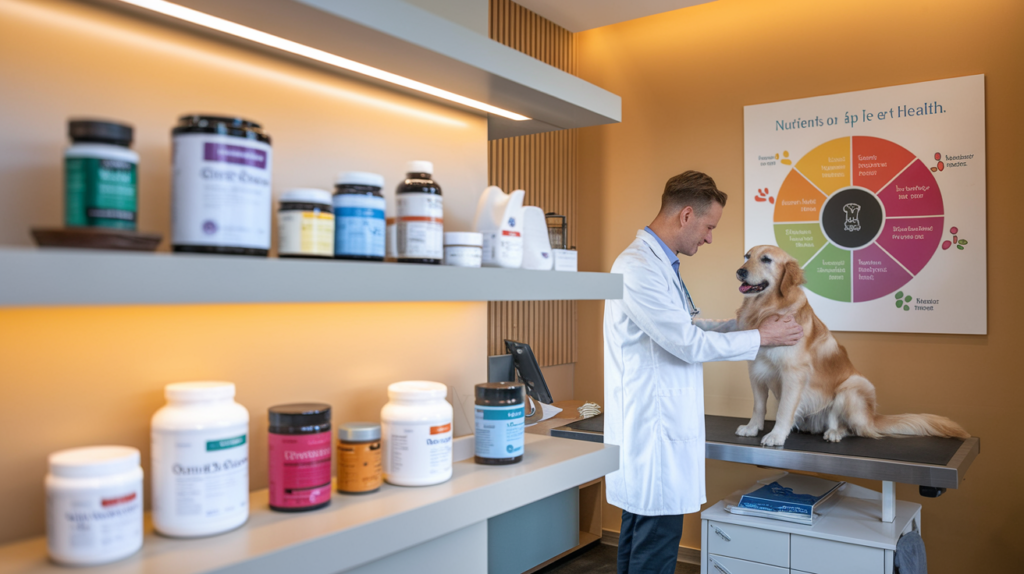
Achieving optimal nutrient concentrations in the body
Orthomolecular approaches for pets focus on providing the right nutrients in optimal concentrations to support their overall health and longevity. This method goes beyond basic nutrition, aiming to achieve a perfect balance of vitamins, minerals, and other essential compounds in your pet’s body.
To achieve optimal nutrient concentrations:
- Conduct regular blood tests
- Analyze nutrient levels
- Adjust diet and supplements accordingly
- Monitor changes over time
Supplementing for therapeutic benefits
Supplementation plays a crucial role in orthomolecular approaches. By providing specific nutrients in therapeutic doses, we can target various health issues and promote overall well-being in pets.
| Supplement | Therapeutic Benefits |
|---|---|
| Omega-3 fatty acids | Reduce inflammation, improve coat health |
| Glucosamine | Support joint health and mobility |
| Probiotics | Enhance gut health and immune function |
| Antioxidants | Combat oxidative stress and aging |
Success Stories and Case Studies
Orthomolecular approaches have shown promising results in many pets. For example, a 12-year-old Labrador with arthritis experienced significant improvement in mobility after following a tailored orthomolecular program for three months. Another case involved a cat with chronic digestive issues that resolved after implementing a targeted nutrient therapy plan.
Caution and Veterinary Supervision
While orthomolecular approaches can be highly beneficial, it’s crucial to proceed with caution and under professional guidance. Always consult with a veterinarian experienced in orthomolecular medicine before starting any new supplement regimen. They can help determine the right balance of nutrients for your pet’s specific needs and monitor progress over time.
Nutrition’s Impact on Common Age-Related Issues
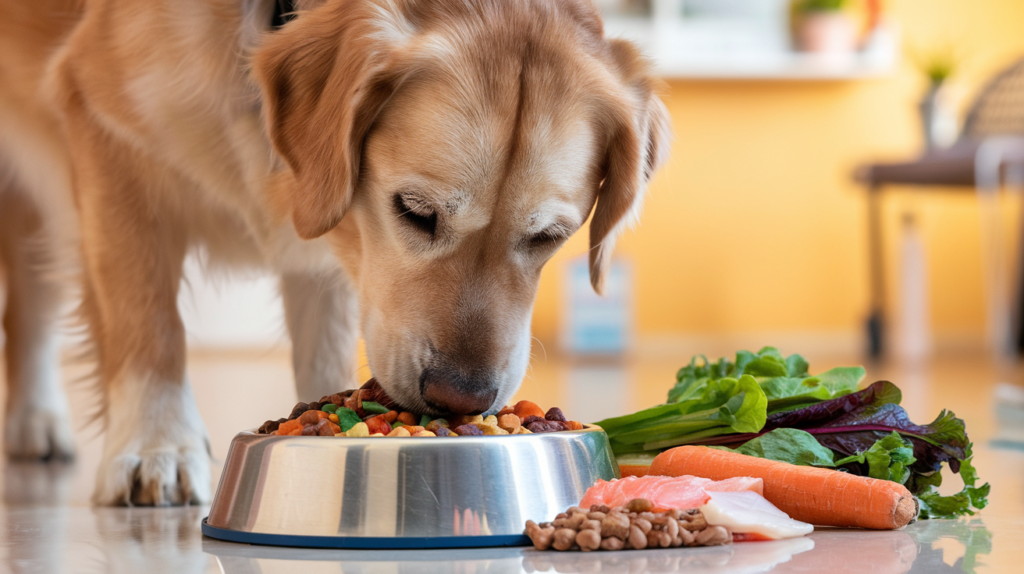
Joint health and mobility
As pets age, joint health becomes a crucial concern. Proper nutrition can significantly impact their mobility and comfort. Here’s how specific nutrients contribute to joint health:
| Nutrient | Benefits for Joint Health |
|---|---|
| Glucosamine | Supports cartilage health |
| Chondroitin | Enhances joint lubrication |
| Omega-3 fatty acids | Reduces inflammation |
| Antioxidants | Protects against oxidative stress |
Incorporating these nutrients into your pet’s diet can help maintain joint flexibility and reduce discomfort associated with aging.
Cognitive function and brain health
Nutrition plays a vital role in maintaining your pet’s cognitive abilities as they age. Key nutrients for brain health include:
- Antioxidants (e.g., vitamins E and C)
- Omega-3 fatty acids (DHA and EPA)
- B-complex vitamins
- Medium-chain triglycerides (MCTs)
These nutrients support neuron function, reduce inflammation, and provide energy for brain cells, potentially slowing cognitive decline in senior pets.
Skin and coat condition
A healthy diet is essential for maintaining your pet’s skin and coat quality. Nutrients that promote skin health and a lustrous coat include:
- Omega-3 and omega-6 fatty acids
- Zinc
- Biotin
- Vitamin A
These nutrients help reduce inflammation, support skin cell turnover, and promote a shiny, healthy coat.
Dental health
Proper nutrition can significantly impact your pet’s dental health, which is often overlooked but crucial for overall well-being. Consider these factors:
- Texture of food (crunchy kibble can help remove plaque)
- Calcium and phosphorus content for strong teeth
- Vitamin C for gum health
- Probiotics to support oral microbiome balance
By addressing these age-related issues through nutrition, you can significantly enhance your pet’s quality of life as they grow older. Next, we’ll explore how to approach dietary changes as part of your New Year’s resolution for your pet’s health.
Making Dietary Changes: A New Year’s Approach

Gradual transition to new diets
When making dietary changes for your pet, it’s crucial to implement them gradually. A sudden switch can lead to digestive upset and may cause your pet to reject the new food entirely. Start by mixing a small amount of the new food with their current diet, gradually increasing the proportion over 7-10 days.
| Day | Old Food | New Food |
|---|---|---|
| 1-3 | 75% | 25% |
| 4-6 | 50% | 50% |
| 7-9 | 25% | 75% |
| 10+ | 0% | 100% |
Setting realistic goals
As you embark on this New Year’s resolution, it’s important to set achievable goals for your pet’s nutrition. Consider the following:
- Weight management (if necessary)
- Increased energy levels
- Improved coat condition
- Better dental health
Remember, changes won’t happen overnight. Give your pet time to adjust and reap the benefits of their new diet.
Tracking progress and adjusting
Monitoring your pet’s response to the new diet is crucial. Keep a log of:
- Weight changes
- Energy levels
- Stool consistency
- Coat condition
- Overall behavior
If you notice any adverse reactions, consult your veterinarian and be prepared to make adjustments. Regular check-ups can help ensure your pet is thriving on their new nutritional plan.
Conclusion

Pets are not mini-humans. They need different amounts of the same basic building blocks—protein, fat, and carbs—to stay healthy. They also need vitamins and minerals that we might not think about. Ever noticed how certain dog foods have added taurine, or how cat foods boast extra vitamin A? That’s because science tells us these micronutrients play a crucial role in everything from good eyesight to strong immune function. And if your pet isn’t getting them from their diet, there can be trouble down the road.
It’s simple stuff, but it’s easy to forget. Especially when your cat gives you that “feed me now” look or your dog begs for the leftover bacon. But remember this: balanced nutrition matters. So feed them with intention, even if those puppy-dog eyes say otherwise.
Proper nutrition plays a pivotal role in ensuring your pet’s longevity and overall well-being. By understanding your pet’s nutritional needs, selecting the right food, and implementing a healthy feeding routine, you can significantly impact their quality of life. Metabolomic insights and orthomolecular approaches offer new perspectives on pet nutrition, allowing for more tailored dietary plans that address common age-related issues.
As you embark on this new year, consider making your pet’s nutrition a priority. It’s a resolution that not only benefits your furry companion but also strengthens the bond you share. By committing to providing balanced, nutrient-rich meals and appropriate supplements, you’re investing in your pet’s health and happiness for years to come. Remember, small changes in diet can lead to big improvements in your pet’s life – making it a truly rewarding resolution to keep.
Call to Action
So here’s the challenge: pick one nutritional change you can make this year. Maybe it’s adding fish oil for those omega-3s. Maybe it’s switching to a diet that’s more calorie-controlled to fight obesity. Or maybe it’s booking a consultation with a vet who knows functional medicine. Your pet deserves it.
Final Thought
Every meal is a chance to invest in your pet’s future. It’s the simplest, most direct way to show you care. So let’s raise a bowl (and maybe a treat) to a healthier, happier life. Because when your pet thrives, you do too.
Further Reading
American Veterinary Medical Association (AVMA). “Pet Nutrition.”
Smith, J. (2022). “Metabolomic Profiles in Aging Dogs and Cats.” Journal of Metabolomics.
The Institute for Functional Medicine. “Functional Nutrition in Veterinary Medicine.”


